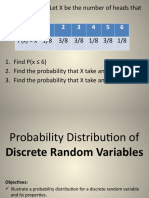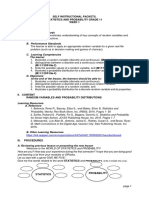0 ratings0% found this document useful (0 votes)
70 viewsDistinguishing Between Parameter and Statistic
The document discusses the key difference between parameters and statistics, which are important concepts in statistics. Parameters describe characteristics of a population, while statistics describe characteristics of a sample from the population. Understanding the difference is necessary for correctly interpreting data and designing studies.
Uploaded by
Dan MonevaCopyright
© © All Rights Reserved
Available Formats
Download as PPTX, PDF, TXT or read online on Scribd
0 ratings0% found this document useful (0 votes)
70 viewsDistinguishing Between Parameter and Statistic
The document discusses the key difference between parameters and statistics, which are important concepts in statistics. Parameters describe characteristics of a population, while statistics describe characteristics of a sample from the population. Understanding the difference is necessary for correctly interpreting data and designing studies.
Uploaded by
Dan MonevaCopyright
© © All Rights Reserved
Available Formats
Download as PPTX, PDF, TXT or read online on Scribd
You are on page 1/ 11
Understanding Parameters and Statistics
Introduction to Parameters
and Statistics
● Parameters and statistics are both
important in the field of statistics.
● A parameter is a characteristic of a
population.
● A statistic is a characteristic of a sample.
● Understanding the difference is key to
interpreting data correctly.
● How might knowing the difference affect
the way we analyze data?
What is a Population?
● A population includes all members of a
specified group.
● It represents the entire set of data you're
interested in.
● Parameters describe aspects of a
population.
● Can you think of an example of a
population in a study?
What is a Sample?
● A sample is a subset of the population.
● It's selected to represent the population in a study.
● Statistics are calculated from sample data.
● Why is it important to choose a representative sample?
Parameters: In-Depth
● Parameters are fixed and usually
unknown.
● They are often denoted by Greek letters
(e.g., μ for mean).
● Parameters are used in inferential
statistics to make predictions about the
population.
● What might be some challenges in
determining a parameter?
Statistics: In-Depth
● Statistics are variable and can be
measured directly.
● They are often denoted by Roman letters
(e.g., x̄ for sample mean).
● Statistics are used to estimate the
population parameter.
● How can statistics be influenced by
sample size and selection?
Estimating Parameters Using Statistics
● We use sample statistics to estimate population parameters.
● The accuracy of the estimation depends on sample size and
quality.
● Confidence intervals can quantify the uncertainty in these
estimates.
● What is a confidence interval, and how does it help in
estimation?
Common Parameters and
Their Corresponding
Statistics
● Population mean (parameter: μ) vs.
Sample mean (statistic: x̄ ).
● Population proportion (parameter: p) vs.
Sample proportion (statistic: p̂ ).
● Population standard deviation (parameter:
σ) vs. Sample standard deviation
(statistic: s).
● Can you match more parameters with
their corresponding statistics?
Importance of
Distinguishing Between
the Two
● Accurate interpretation of research
findings.
● Understanding the scope of conclusions
(population vs. sample).
● Designing better experiments and
surveys.
● What could be the consequences of
confusing a parameter with a statistic?
Real-World Application: Using Parameters and Statistics
● In healthcare, parameters might represent the true recovery rate
of a disease.
● In education, statistics could show the average test score of a
classroom.
● In business, understanding these concepts helps make informed
decisions.
● Think of an industry where this distinction is crucial. Why?
Conclusion: The Power of
Data Interpretation
● Distinguishing between parameters and
statistics is vital for accurate data
analysis.
● It allows for better decision-making and
understanding of studies.
● Always consider whether you're dealing
with a population or a sample.
● How will you apply this knowledge in your
future data analyses?
You might also like
- Experiment 1: Errors, Uncertainties and Measurements Laboratory ReportNo ratings yetExperiment 1: Errors, Uncertainties and Measurements Laboratory Report8 pages
- PSUnit II Lesson 5 Locating Percentiles Under The Normal CurveNo ratings yetPSUnit II Lesson 5 Locating Percentiles Under The Normal Curve13 pages
- Daily Lesson Log of Stem - Bc11Lc-Iiib-1No ratings yetDaily Lesson Log of Stem - Bc11Lc-Iiib-12 pages
- HI! I'm Teacher Maricel Welcome To Our Classroom!33% (3)HI! I'm Teacher Maricel Welcome To Our Classroom!23 pages
- Department of Education: Republic of The PhilippinesNo ratings yetDepartment of Education: Republic of The Philippines69 pages
- Identifying Appropriate Test Statistics Involving Population MeanNo ratings yetIdentifying Appropriate Test Statistics Involving Population Mean2 pages
- (L3.2) - Hypothesis Testing - Type I and Type II ErrorNo ratings yet(L3.2) - Hypothesis Testing - Type I and Type II Error16 pages
- Statistics AND Probability: Informatic Computer Institute of Agusan Del Sur Inc. Sanfrancisco, Agusan Del Sur100% (1)Statistics AND Probability: Informatic Computer Institute of Agusan Del Sur Inc. Sanfrancisco, Agusan Del Sur39 pages
- Interval Estimate of Population ProportionNo ratings yetInterval Estimate of Population Proportion21 pages
- Rational Functions, Equation and Inequality: LEARNING ACTIVITY SHEETS Senior High School-General Mathematics100% (1)Rational Functions, Equation and Inequality: LEARNING ACTIVITY SHEETS Senior High School-General Mathematics6 pages
- Learning Activity Sheets: General Mathematics Quarter 1 - Week 1BNo ratings yetLearning Activity Sheets: General Mathematics Quarter 1 - Week 1B7 pages
- Daily Lesson Log of Stem - Bc11Lc-Iiic-2 (Week Three-Day Two)No ratings yetDaily Lesson Log of Stem - Bc11Lc-Iiic-2 (Week Three-Day Two)3 pages
- Probability Distribution of Discrete Random VariablesNo ratings yetProbability Distribution of Discrete Random Variables8 pages
- Q3 - Summative Test2 - Statprob 2022 2023No ratings yetQ3 - Summative Test2 - Statprob 2022 20232 pages
- IDEA Exemplar in Statistics and Probability Quarter 4 Week 6 COT 2 JUN 30 2023No ratings yetIDEA Exemplar in Statistics and Probability Quarter 4 Week 6 COT 2 JUN 30 202313 pages
- GenMath Q2 W7 Business and Consumer LoansNo ratings yetGenMath Q2 W7 Business and Consumer Loans40 pages
- Forms of Test Statistic For The Population Mean: Lesson 13.2No ratings yetForms of Test Statistic For The Population Mean: Lesson 13.227 pages
- Solving Problems Involving Test of Hypothesis On A Population Proportion 4No ratings yetSolving Problems Involving Test of Hypothesis On A Population Proportion 416 pages
- Measures of Central Tendency and VariabilityNo ratings yetMeasures of Central Tendency and Variability24 pages
- c1l5 Variance of A Discrete Probability DistributionNo ratings yetc1l5 Variance of A Discrete Probability Distribution52 pages
- Major Performance Task in Statistics and Probability 2 Semester Grade 11 Faith-STEMNo ratings yetMajor Performance Task in Statistics and Probability 2 Semester Grade 11 Faith-STEM19 pages
- Solving Logarithmic Equations and Inequalities Part 1100% (1)Solving Logarithmic Equations and Inequalities Part 19 pages
- MODULE 5 Business and Consumer Loans - Part 1 PDF0% (1)MODULE 5 Business and Consumer Loans - Part 1 PDF24 pages
- Name: Grade & Section: Score: Your Answer Sheet. 1. Which of The Following Represents Normal Distribution? A. CNo ratings yetName: Grade & Section: Score: Your Answer Sheet. 1. Which of The Following Represents Normal Distribution? A. C3 pages
- The Higher Order Derivatives of FunctionsNo ratings yetThe Higher Order Derivatives of Functions15 pages
- PRISMA 2009 Flow Diagram: For More Information, VisitNo ratings yetPRISMA 2009 Flow Diagram: For More Information, Visit1 page
- Animal Magnetism - A Practical and Scientific Approach: Find Us On67% (3)Animal Magnetism - A Practical and Scientific Approach: Find Us On102 pages
- Instant Access to (eBook PDF) Health Services Research Methods 3rd Edition ebook Full Chapters100% (5)Instant Access to (eBook PDF) Health Services Research Methods 3rd Edition ebook Full Chapters50 pages
- Elements of The Socratic Method - IV - Disavowal of Knowledge100% (1)Elements of The Socratic Method - IV - Disavowal of Knowledge10 pages
- Statistical Soup - ANOVA, ANCOVA, MANOVA, & MANCOVANo ratings yetStatistical Soup - ANOVA, ANCOVA, MANOVA, & MANCOVA1 page
- Advanced Quantum Field Theory Example Sheet 4: Lent 2021No ratings yetAdvanced Quantum Field Theory Example Sheet 4: Lent 202130 pages
- Makri Neely 2021 Grounded Theory A Guide For Exploratory Studies in Management ResearchNo ratings yetMakri Neely 2021 Grounded Theory A Guide For Exploratory Studies in Management Research14 pages
- Chapter 2. Classifiers Based On Bayes Decision TheoryNo ratings yetChapter 2. Classifiers Based On Bayes Decision Theory1 page
- Overseas Marketing Corporation (PVT.) LTD.: Analytical Instrument ListNo ratings yetOverseas Marketing Corporation (PVT.) LTD.: Analytical Instrument List2 pages
- BEED 18 (midterms reviewer - 1st sem - 3rd year)No ratings yetBEED 18 (midterms reviewer - 1st sem - 3rd year)6 pages
- STA2023 Final Exam Grade Saver Fall 14 (New) Notes PDFNo ratings yetSTA2023 Final Exam Grade Saver Fall 14 (New) Notes PDF36 pages
- Research Title in Bold, Uppercase Letters Following An Inverted Pyramid Form Not Exceeding 12 WordsNo ratings yetResearch Title in Bold, Uppercase Letters Following An Inverted Pyramid Form Not Exceeding 12 Words6 pages
- Research Design Explained 7th Edition Mark L. Mitchell Download PDF100% (3)Research Design Explained 7th Edition Mark L. Mitchell Download PDF84 pages
- PDF Norms Groups Conflict and Social Change Rediscovering Muzafer Sherif s Psychology 1st Edition Ayfer Dost-Gözkan (Editor) download100% (14)PDF Norms Groups Conflict and Social Change Rediscovering Muzafer Sherif s Psychology 1st Edition Ayfer Dost-Gözkan (Editor) download85 pages
- Experiment 1: Errors, Uncertainties and Measurements Laboratory ReportExperiment 1: Errors, Uncertainties and Measurements Laboratory Report
- PSUnit II Lesson 5 Locating Percentiles Under The Normal CurvePSUnit II Lesson 5 Locating Percentiles Under The Normal Curve
- Department of Education: Republic of The PhilippinesDepartment of Education: Republic of The Philippines
- Identifying Appropriate Test Statistics Involving Population MeanIdentifying Appropriate Test Statistics Involving Population Mean
- (L3.2) - Hypothesis Testing - Type I and Type II Error(L3.2) - Hypothesis Testing - Type I and Type II Error
- Statistics AND Probability: Informatic Computer Institute of Agusan Del Sur Inc. Sanfrancisco, Agusan Del SurStatistics AND Probability: Informatic Computer Institute of Agusan Del Sur Inc. Sanfrancisco, Agusan Del Sur
- Rational Functions, Equation and Inequality: LEARNING ACTIVITY SHEETS Senior High School-General MathematicsRational Functions, Equation and Inequality: LEARNING ACTIVITY SHEETS Senior High School-General Mathematics
- Learning Activity Sheets: General Mathematics Quarter 1 - Week 1BLearning Activity Sheets: General Mathematics Quarter 1 - Week 1B
- Daily Lesson Log of Stem - Bc11Lc-Iiic-2 (Week Three-Day Two)Daily Lesson Log of Stem - Bc11Lc-Iiic-2 (Week Three-Day Two)
- Probability Distribution of Discrete Random VariablesProbability Distribution of Discrete Random Variables
- IDEA Exemplar in Statistics and Probability Quarter 4 Week 6 COT 2 JUN 30 2023IDEA Exemplar in Statistics and Probability Quarter 4 Week 6 COT 2 JUN 30 2023
- Forms of Test Statistic For The Population Mean: Lesson 13.2Forms of Test Statistic For The Population Mean: Lesson 13.2
- Solving Problems Involving Test of Hypothesis On A Population Proportion 4Solving Problems Involving Test of Hypothesis On A Population Proportion 4
- c1l5 Variance of A Discrete Probability Distributionc1l5 Variance of A Discrete Probability Distribution
- Major Performance Task in Statistics and Probability 2 Semester Grade 11 Faith-STEMMajor Performance Task in Statistics and Probability 2 Semester Grade 11 Faith-STEM
- Solving Logarithmic Equations and Inequalities Part 1Solving Logarithmic Equations and Inequalities Part 1
- Name: Grade & Section: Score: Your Answer Sheet. 1. Which of The Following Represents Normal Distribution? A. CName: Grade & Section: Score: Your Answer Sheet. 1. Which of The Following Represents Normal Distribution? A. C
- PRISMA 2009 Flow Diagram: For More Information, VisitPRISMA 2009 Flow Diagram: For More Information, Visit
- Animal Magnetism - A Practical and Scientific Approach: Find Us OnAnimal Magnetism - A Practical and Scientific Approach: Find Us On
- Instant Access to (eBook PDF) Health Services Research Methods 3rd Edition ebook Full ChaptersInstant Access to (eBook PDF) Health Services Research Methods 3rd Edition ebook Full Chapters
- Elements of The Socratic Method - IV - Disavowal of KnowledgeElements of The Socratic Method - IV - Disavowal of Knowledge
- Statistical Soup - ANOVA, ANCOVA, MANOVA, & MANCOVAStatistical Soup - ANOVA, ANCOVA, MANOVA, & MANCOVA
- Advanced Quantum Field Theory Example Sheet 4: Lent 2021Advanced Quantum Field Theory Example Sheet 4: Lent 2021
- Makri Neely 2021 Grounded Theory A Guide For Exploratory Studies in Management ResearchMakri Neely 2021 Grounded Theory A Guide For Exploratory Studies in Management Research
- Chapter 2. Classifiers Based On Bayes Decision TheoryChapter 2. Classifiers Based On Bayes Decision Theory
- Overseas Marketing Corporation (PVT.) LTD.: Analytical Instrument ListOverseas Marketing Corporation (PVT.) LTD.: Analytical Instrument List
- STA2023 Final Exam Grade Saver Fall 14 (New) Notes PDFSTA2023 Final Exam Grade Saver Fall 14 (New) Notes PDF
- Research Title in Bold, Uppercase Letters Following An Inverted Pyramid Form Not Exceeding 12 WordsResearch Title in Bold, Uppercase Letters Following An Inverted Pyramid Form Not Exceeding 12 Words
- Research Design Explained 7th Edition Mark L. Mitchell Download PDFResearch Design Explained 7th Edition Mark L. Mitchell Download PDF
- PDF Norms Groups Conflict and Social Change Rediscovering Muzafer Sherif s Psychology 1st Edition Ayfer Dost-Gözkan (Editor) downloadPDF Norms Groups Conflict and Social Change Rediscovering Muzafer Sherif s Psychology 1st Edition Ayfer Dost-Gözkan (Editor) download
































































































